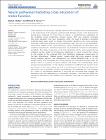| dc.contributor.author | CARSON, RICHARD | en |
| dc.contributor.author | RUDDY, KATHY | en |
| dc.date.accessioned | 2013-09-26T11:13:17Z | |
| dc.date.available | 2013-09-26T11:13:17Z | |
| dc.date.issued | 2013 | en |
| dc.date.submitted | 2013 | en |
| dc.identifier.citation | Ruddy KL, Carson RG, Neural pathways mediating cross education of motor function., Frontiers in human neuroscience, 7, 2013, 397 | en |
| dc.identifier.issn | 1662-5161 | en |
| dc.identifier.other | Y | en |
| dc.identifier.uri | http://hdl.handle.net/2262/67440 | |
| dc.description | PUBLISHED | en |
| dc.description.abstract | Cross education is the process whereby training of one limb gives rise to enhancements in the performance of the opposite, untrained limb. Despite interest in this phenomenon having been sustained for more than a century, a comprehensive explanation of the mediating neural mechanisms remains elusive. With new evidence emerging that cross education may have therapeutic utility, the need to provide a principled evidential basis upon which to design interventions becomes ever more pressing. Generally, mechanistic accounts of cross education align with one of two explanatory frameworks. Models of the ?cross activation? variety encapsulate the observation that unilateral execution of a movement task gives rise to bilateral increases in corticospinal excitability. The related conjecture is that such distributed activity, when present during unilateral practice, leads to simultaneous adaptations in neural circuits that project to the muscles of the untrained limb, thus facilitating subsequent performance of the task. Alternatively, ?bilateral access? models entail that motor engrams formed during unilateral practice, may subsequently be utilized bilaterally?that is, by the neural circuitry that constitutes the control centers for movements of both limbs. At present there is a paucity of direct evidence that allows the corresponding neural processes to be delineated, or their relative contributions in different task contexts to be ascertained. In the current review we seek to synthesize and assimilate the fragmentary information that is available, including consideration of knowledge that has emerged as a result of technological advances in structural and functional brain imaging. An emphasis upon task dependency is maintained throughout, the conviction being that the neural mechanisms that mediate cross education may only be understood in this context. | en |
| dc.description.sponsorship | UK Biotechnology and Biological Sciences Research Council (ID: BB/I008101/1). | en |
| dc.format.extent | 397 | en |
| dc.language.iso | en | en |
| dc.relation.ispartofseries | Frontiers in human neuroscience | en |
| dc.relation.ispartofseries | 7 | en |
| dc.rights | Y | en |
| dc.subject | interlimb | en |
| dc.subject | bilateral | en |
| dc.subject | transfer | en |
| dc.subject | motor learning | en |
| dc.subject | interhemispheric | en |
| dc.title | Neural pathways mediating cross education of motor function. | en |
| dc.type | Journal Article | en |
| dc.contributor.sponsor | Biotechnology and Biological Sciences Research Council (BBSRC) | en |
| dc.type.supercollection | scholarly_publications | en |
| dc.type.supercollection | refereed_publications | en |
| dc.identifier.peoplefinderurl | http://people.tcd.ie/ricarson | en |
| dc.identifier.peoplefinderurl | http://people.tcd.ie/ruddykl | en |
| dc.identifier.rssinternalid | 88611 | en |
| dc.identifier.doi | http://dx.doi.org/10.3389/fnhum.2013.00397 | en |
| dc.rights.ecaccessrights | OpenAccess | |
| dc.contributor.sponsorGrantNumber | BB/I008101/1 | en |
| dc.subject.TCDTheme | Neuroscience | en |
| dc.subject.TCDTag | Neuropsychology | en |
| dc.identifier.orcid_id | 0000-0002-1190-2814 | en |
| dc.status.accessible | N | en |




